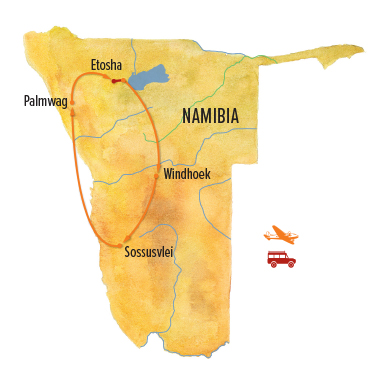Day 1: Windhoek, Namibia
Our Namibia wildlife safari begins on arrival in Windhoek. Namibia's capital is a modern, walkable city with an eclectic urban skyline featuring both contemporary and colonial architecture, from German castles and cathedral spires to glass skyscrapers. There's time to relax this afternoon at our boutique hotel in a tranquil neighborhood before a welcome dinner with our Expedition Leader.
Days 2–4: Private Kulala Wilderness Reserve—Sossusvlei Dunes
Fly by light aircraft to Little Kulala, a luxurious retreat inside the private 90,000-acre Kulala Wilderness Reserve on the edge of Namibia’s great sand sea. The word
namib in the Nama language means “vast,” an apt name for this ancient arid expanse—the world’s oldest desert. Wildlife drives at sunrise take us into Sossusvlei, a salt and clay pan surrounded by shape-shifting sand dunes. Framed by intense blue skies, the world’s tallest dunes glow deep carnelian at dawn, changing minute by minute as the sun climbs, to rose, burnt orange and ochre. Inside are diamonds, tucked into the sand mountains by currents, waves and wind. Remarkably, these dunes are home to a host of desert species, including oryx, ostrich, springbok, spotted and brown hyena, aardwolf and bat-eared fox. The rare dune lark’s entire habitat is confined to this area. Discover the desert’s subtle magic on short walks and safari drives. An optional hot air balloon safari with a champagne breakfast upon landing is also available (additional cost) during our stay at Kulala Wilderness Reserve. From Little Kulala’s profoundly secluded vantage point, experience some of Africa’s most arresting vistas, including vermilion sunsets and unparalleled stargazing.
Days 5 & 6: Palmwag Concession—Rhino Tracking
Fly north to the private million-acre Palmwag Concession. Our destination, Desert Rhino Camp, lies at the heart of this vast reserve in Damaraland, one of Africa's last great wildernesses. Few safari locales offer the level of isolation found here. The raw landscape is defined by ancient riverbeds, open plains, stacked granite rocks and deep gorges. Within these stark environs, freshwater springs support healthy numbers of wildlife, including Africa's largest population of free-roaming black rhinos. We'll track this endangered icon in the company of rhinoceros experts from Save the Rhino Trust and researchers based at the camp. To search for rhinos on foot is a rare and exhilarating experience. Taking care to stay downwind, silent and hiding behind scrub bushes, we hold our breath in anticipation of spying this ancient desert dweller. On 4x4 drives, look also for desert-adapted elephant, endemic Hartmann’s mountain zebra, giraffe, oryx, gemsbok, springbok, greater kudu and possibly even predators. Birds are abundant, with a number of southern African endemics.
Days 7–9: Etosha National Park—Ongava Private Reserve
Today we fly to the Ongava Game Reserve bordering Etosha National Park. Within this private concession, wildlife thrives while visitors are few. Our focus is the Etosha Salt Pan, the remnant of a huge lake that existed here 2 million years ago. Bare and dry today, the depression offers Namibia’s best wildlife viewing, with elephant, black and white rhinoceros, lion, leopard, cheetah, giraffe, zebra, wildebeest, hartebeest, springbok, oryx, kudu and the diminutive dik-dik drawn to the many life-sustaining waterholes. Birdlife is prolific, and we may see ostrich and raptors. From camp, take guided walks (safety permitting) and night drives on the reserve, traveling into the adjacent national park by day, then retreating to solitude each evening.
Day 10: Windhoek / Depart
Our Namibia safari concludes as we fly from Ongava back to Windhoek to connect with departing flights.
























